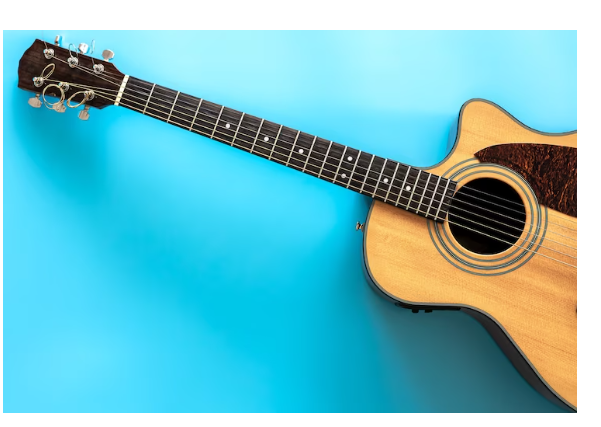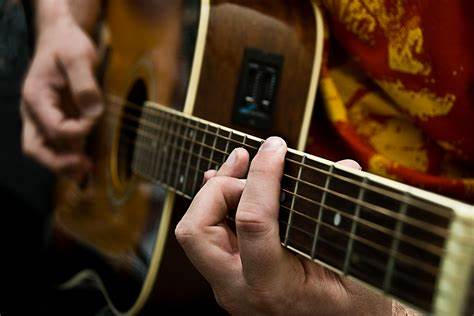The ability to tune a guitar is crucial for every guitarist, whether they are amateur or professionals. Adjusting the string tension on a guitar ensures that it plays at the desired pitch. A guitar that is out of tune is difficult to perform with other instruments or recordings and is also unpleasant to listen to.
Using a tuner for guitar tune is the most popular technique of tuning a guitar, although there are other options. A tuner is a gadget or program that analyses the guitar's sound and indicates if a string is tuned too high or too low. You can get tuners at any record shop, and there are plenty of free programs available for smartphones. Here's how to use a tuner to get your guitar just right:
- Activate the tuner and position it where you can see it.
- Tune your instrument by playing the lowest string (the thickest one). The string is in tune if the needle or indication is centred. If it's too far to the left, the string has a low pitch; if it's too far to the right, the string has a high pitch.
- Put the low E string's tuning peg in the middle so that the indicator or needle is dead centre.
- The remaining five strings—A, D, G, B, and high E—should be treated similarly.
The guitar tune should be tuned often, preferably before each and every use. This is because the strings may expand or contract according to environmental factors including temperature and humidity, as well as the player's touch. Your guitar will be much more difficult to play and will put extra wear and tear on the strings and instrument if you don't tune it periodically.

Too much or too little tension on the strings may cause the neck or bridge of the guitar to distort or shatter. Preventing this from occurring and extending the life of your guitar may be as simple as keeping it in tune.
There are alternative ways to tune a guitar besides utilising an electronic tuner, such as using a pitch pipe or tuning forks. These approaches call on an acute sense of pitch, making them challenging for novices. But if you don't have a tuner or would rather tune by ear, they may be helpful.
Learning how a guitar should sound is also crucial for getting it in tune. The low E string of a guitar is usually tuned at 82.4 hertz (EADGBE). This implies that the guitar's tone may be controlled by changing the frequency at which each string vibrates. If you're ever forced to tune your guitar by ear, knowing what a well-tuned instrument sounds like can come in handy.
Many distinct sounds and musical genres may be achieved by using tunings other than standard tuning. Drop tunings, such as Drop D or Drop C# are popular in heavy metal and hard rock, whereas open tunings, such as Open G or Open D, are employed in blues and slide guitar playing. If you want to broaden your musical horizons and explore new sounds, try playing your instrument in a variety of tunings.

What is Tuning?
So, what is tuning? In guitar, adjusting the string tension to ensure that it plays at the desired pitch is known as tuning. To get the finest tone and intonation out of your guitar, you need to keep it in tune. A real tuner, a tuning app, or even just your ears may help you get your instrument in tune. Quickly tune your guitar using these suggestions.
- Invest in a tuner; doing so is the fastest and most precise method of getting your guitar in tune. You may find tuners in many different forms, such as physical devices, mobile applications, and internet resources. Always use a trusted tuner when fine-tuning your guitar.
- It's best to tune your guitar in a quiet room, since ambient noise might prevent the tuner from correctly detecting string pitch. If you want to tune your guitar, you should do it in peace and quiet.
- Use harmonics, since they are the most organic approach to tune your guitar. Try playing a harmonic on the 12th fret of one string and then the identical harmonic on the adjacent string and see how they sound in comparison. If the two harmonics are in tune, they will have the same tone. You may use this technique to verify the accuracy of your tune.
- Tune the lowest string first, the low E, and then go up to the highest string, the high E. This keeps the strings at a consistent tension and slows the rate at which they may go out of tune.
If you have just put on a new set of strings or haven't played in a while, you should stretch them out by gently pushing on them. This will aid in the string's settling process and lessen the frequency with which it goes out of tune. You may accomplish this by repeatedly stretching the string away from the fretboard and letting it go.
Common Types of Guitar Tuners (and How They Work)
There are two common types of guitar tuners: clip-on tuners and pedal tuners.
Clip-on tuners attach to the headstock of the guitar and use a vibration sensor to detect the frequency of the vibrating string. When the user plucks a string, the tuner senses the vibration and displays the corresponding note on a small screen. The user can then adjust the tuning until the displayed note matches the desired pitch.
Pedal tuners are larger units that are typically used on stage or in a studio setting. They are designed to be used with an electric guitar, as they require an input signal from the guitar's pickup. When the user plays a note or chord on the guitar, the tuner analyzes the signal and displays the corresponding note on a large LED display. The user can then adjust the tuning until the displayed note matches the desired pitch.
Both types of tuners are widely used by guitarists and have their advantages and disadvantages. Clip-on tuners are small, portable, and easy to use, making them a popular choice for beginner and intermediate guitarists. However, they may not be as accurate as pedal tuners, especially in noisy environments.
Pedal tuners, on the other hand, are more expensive and require more setup, but they are typically more accurate and reliable, making them a popular choice for professional guitarists.
How Guitar Tuners Work: Note-By-Note Tuners vs. Polyphonic Tuners
Guitar tuners are devices used to tune guitars by measuring the pitch of each string and indicating whether the pitch is too high, too low, or in tune.
Note-by-note tuners work by measuring the pitch of each string individually. The user plucks a string, and the tuner detects the pitch of that string. The tuner then indicates whether the string is too high, too low, or in tune, and the user adjusts the tuning accordingly. This process is repeated for each string until all strings are in tune.
Polyphonic tuners, on the other hand, are capable of detecting the pitch of all strings at once. This allows the user to tune all six strings of a guitar simultaneously, rather than tuning each string individually. Polyphonic tuners work by using advanced signal processing algorithms to analyze the combined frequencies of all six strings. The tuner then indicates which strings are too high, too low, or in tune, and the user adjusts the tuning accordingly.
Both types of tuners have their advantages and disadvantages. Note-by-note tuners are typically more accurate and reliable than polyphonic tuners, as they measure each string individually.
However, they can be time-consuming to use, as the user must tune each string one at a time. Polyphonic tuners are faster and more convenient, as they allow the user to tune all six strings at once. However, they may be less accurate than note-by-note tuners, especially in noisy environments.
Note-by-note tuners measure the pitch of each string individually, while polyphonic tuners detect the pitch of all strings at once.


Why and How Guitar Tuning Enhances Playability?
Guitar tuning is crucial if you want to play better. Here are some of the benefits of fine-tuning your guitar:
Improved Sound
When your guitar is in tune, the sound it creates is more distinct, fuller, and well-balanced. Playing and listening will be more pleasurable as a result of the improved quality of the sound.
Playing is Simplified
Trying to play the guitar that isn't in tune might be an exercise in frustration. If your guitar is in tune, the notes will be at the right pitch, making it simpler to play chords, scales, and arpeggios. Because of this, you may play with more precision and assurance.
Improved Intonation
Intonation is the precision with which the notes on a certain fret are played. When a guitar is properly tuned, the notes played at each fret are more in harmony with one another, a phenomenon known as "intonation." If you want your guitar notes to fit in with the rest of the band or if you're playing lead guitar, this is crucial.
Consistency in Performance
A guitar that has been properly tuned will sound the same every time you play it. This will help you play in time with the rest of the band, whether you're recording, performing, or doing both.
Take guitar lessons on Superprof.
Learn the Guitar Strings Tuning
Adjusting the guitar strings tuning on a guitar ensures that it plays at the desired pitch. Each guitar string's standard tuning frequency is listed below:
- 6th string (thickest string): E2 (82.41 Hz)
- 5th string: A2 (110 Hz)
- 4th string: D3 (146.83 Hz)
- 3rd string: G3 (196 Hz)
- 2nd string: B3 (246.94 Hz)
- 1st string (thinnest string): E4 (329.63 Hz)
Using a tuner is the quickest and most precise method to get your guitar strings in tune. You may find tuners in many different forms, such as physical devices, mobile applications, and internet resources. Always use a trusted tuner when fine-tuning your guitar.
The use of harmonics is a more organic approach to tuning guitar strings. Consider the difference between a harmonic played on the sixth string's fifth fret and the fifth string's seventh fret. If the two harmonics are in tune, they will have the same tone. You may use this technique to verify the accuracy of your tune.
When tuning your guitar by ear, you may use relative tuning. The best place to start is by tuning the sixth string to the right pitch (E2), and then working outwards from there. To tune the fifth string, you can play the sixth string at the fifth fret and the fifth string open. Tweak the 5th string's tension until its note is identical to that of the 6th string at the 5th fret.

How to Tune a Guitar With Your Phone
Tuning a guitar with your phone is a convenient and cost-effective option, as many guitar tuning apps are available for free or for a small fee. Here are the steps to tune your guitar with your phone:
- Download a guitar tuning app on your phone. Some popular options include GuitarTuna, Fender Tune, and PitchLab.
- Open the app and select the option for guitar tuning.
- Choose the type of guitar you have (acoustic or electric) and the tuning you want to use (standard tuning, drop D tuning, etc.).
- Play each string of the guitar one at a time. The app will display the note that the string is currently tuned to and indicate whether it is too high, too low, or in tune.
- Adjust the tuning of each string until it matches the desired pitch. You can use the tuning pegs on the headstock of the guitar to make small adjustments to the tension of each string.
- Repeat this process for each string until all strings are in tune.
- Once all strings are in tune, play a few chords or scales to test the tuning. If the guitar still sounds out of tune, repeat the process until the tuning is correct.
Tuning a guitar with your phone is a convenient option for practicing at home or on the go.
Résumer avec l'IA :















